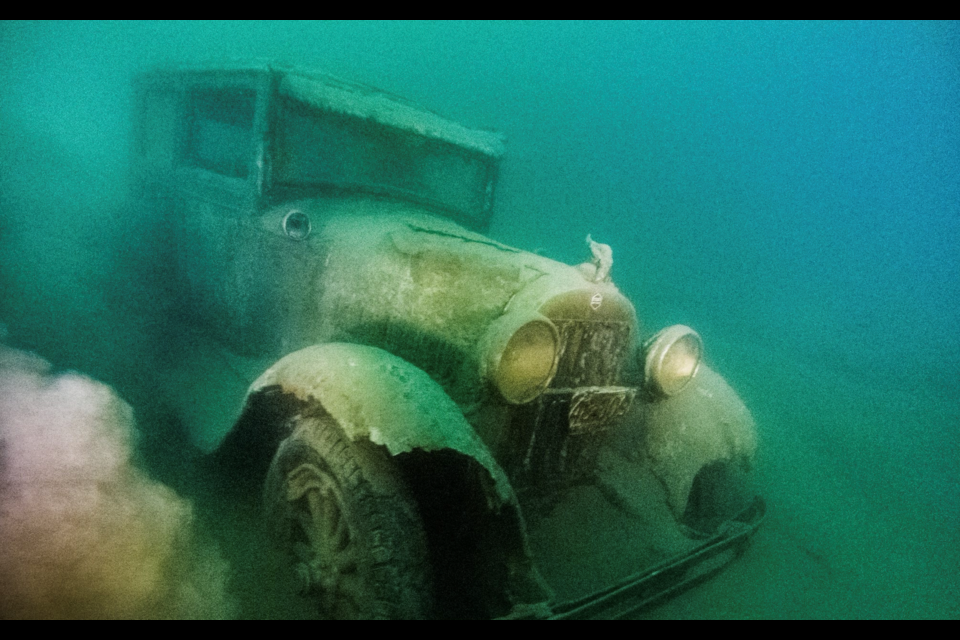BANFF – A decades-old mystery surrounding whether a vintage vehicle submerged deep beneath the surface of Banff’s Lake Minnewanka was based on fact or fiction has been solved by a team of scuba divers.
The legendary story that has been passed down through the decades is of a man who drove his vehicle onto the frozen lake to photograph the surrounding stunning mountains, only to hopelessly watch the car plunge through the ice as he was setting up his camera on a tripod.
A team of divers recently found a vehicle – believed to be a 1928 Hudson Essex Saloon based upon matching images on the internet – at a depth of almost 60 metres following months of planning and trying to line up schedules to dive once the ice came off the lake.
“There’s always been a rumour, a story that there was a vehicle under there,” said Calgarian Alan Keller, one of the three divers who found the vehicle about three to four kilometres from the boat launch.
“Then when we saw it, it was pretty amazing. It was incredible that we actually found it and that we’re able to dive that.”
This dive was conducted by the VexNow dive team, made up of Keller, Brian Nadwidny, of Edmonton, and John Ryan, of Airdrie.
Based upon sonar scanning work done by others over the last few years confirming a vehicle underwater in Lake Minnewanka, the divers set out on May 22 and 23.
Keller said there were certainly challenges in relocating such a small target, noting they had to be sure everything was correct before diving down 55 metres in water that is 4 Celsius with uncertainty of the visibility so far beneath the surface.
“However, patience pays off and our shot line was within seven metres of the target and visibility was about six metres,” he said.
“Weather was also on our side as it can be pretty sketchy in May in Banff National Park.”
Keller said the 1928 Hudson Essex Saloon had Saskatchewan licence plates from 1940, with red letters on a white background.
He said local motor vehicle licensing history indicates plates were issued every year with different colouring.
Tucked under the visor on the driver’s side of the vehicle, he said there was also a national park pass, a metal buffalo, that were issued from 1925 until 1940.
“So both the plate and the park pass date this car to being 85 years underwater,” said Keller.
Keller said the divers had a pretty good idea of the vehicle’s location based on side-scan sonar in 2020 from searchers trying to find the body of a man who was presumed drowned – Yannick Bastien, a 26-year-old at the time he went missing on Sept. 21, 2019.
“It was one of the hits that found this [vehicle] underwater,” said Keller.
Led by Ryan, the dive was planned around when ice melted off Lake Minnewanka when the visibility is typically better and the water level lower.
With the vehicle projected to be sitting approximately 60 metres below the surface, Ryan reached out to both Keller and Nadwidny, who had dive training to that depth.
Keller said they had a GPS and a relatively unsophisticated sonar system to help with the search.
“We wanted to try to make sure that we had it right because diving down to that depth, you really want to be confident in the spot and not be messing around too much underwater,” he said.
Based on the GPS and sonar equipment, the divers set up the shot line – essentially a weight, a line and a buoy to help as a visual or tactile reference to more safely descend and ascend back to the surface.
“We didn’t see it right away because it was about seven metres away and visibility was about six metres, so we had to do a little bit of a smoke search pattern,” he said.
“You swim a little bit aways away from your line and then you come back to it, then go in another direction and come back to it, so we did about three or four of those and then we saw it.”
Under the Canada National Parks Act, removal of artifacts is illegal in national parks.
Keller said, however, taking and sharing photos of the find is “cool.”
“I feel pretty happy about just being able to share the pictures with the public,” said Keller.
“That’s what makes it different is it’s a national park and so it belongs to everybody technically.”




